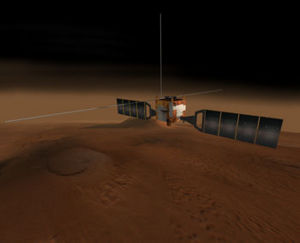Mars Express
Mars Express was launched on June 2, 2003 from Baikonur Cosmodrome (Kazakhstan) on a Soyuz-Fregat rocket to search for water and the possibility of Martian life. Consisting of a low-cost orbiter and lander, Mars Express is a European Space Agency (ESA) mission to the Red Planet involving a consortium of countries (primarily France, Germany, Great Britain, Ireland, Italy, Japan, the Netherlands, Norway, Russia, Sweden, Spain, and the United States). In February 2007, Mars Express was granted a second mission extension until May 2009.
Mission Overview

Mars Express was a two-component mission consisting of the Mars Express Orbiter and Beagle 2 lander. Unfortunately, the Beagle 2 lander failed on entry into the Martian atmosphere and was lost on Christmas Day, 2003. The crash site of Beagle 2 was later imaged by NASA's Mars Global Surveyor in a crater near the planned landing site of the equatorial region known as Isidis Planitia. Despite this early loss, the Mars Express orbiter continues on its mission to explore the Martian surface.
Mars Express will be providing support for the NASA Phoenix lander when it arrives on Mars in mid-2008.
Great stuff, you hpeeld me out so much!
Scientific Discoveries
Mars Express has made several important discoveries during its mission:
- Detection of water in the southern polar icecap using OMEGA (2004)
- Detection of methane & ammonia in the Martian atmosphere using PFS (2004)
- Location of an area of water ice near the north pole using HRSC (2005)
- Mapping the location and thickness of water ice in the south pole with the MARSIS instrument (2007)
It has also carried out a wide variety of other important observations which have increased understanding of the Martian atmosphere and geology.







